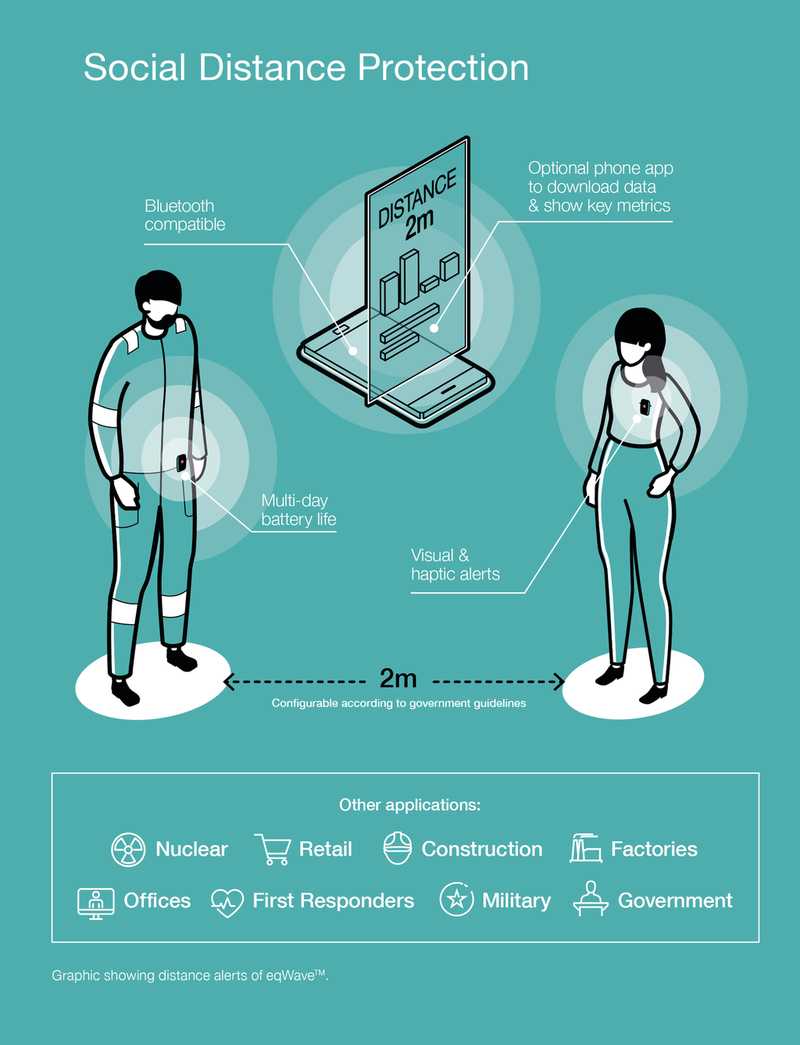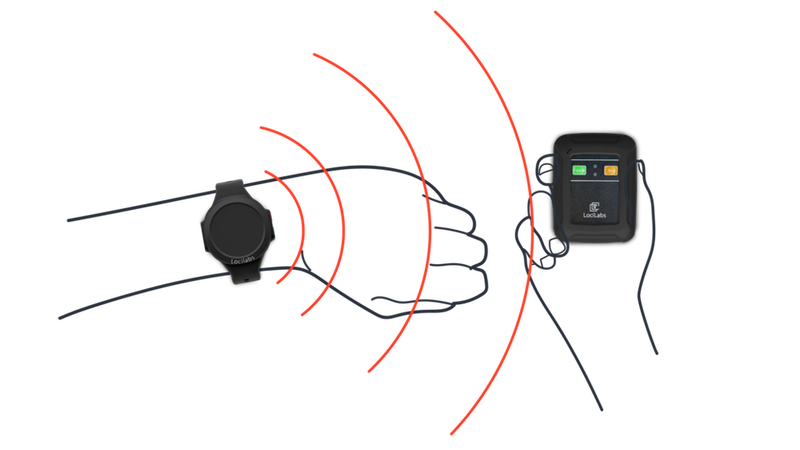Wearable Technology
Social Distancing Wearables: The Next Major Industry Trend?
Wearables have enjoyed steady growth, but the coronavirus pandemic may turbocharge adoption. Ellen Daniel explores whether social distancing could become the key application for wearables

From fashion, to fitness, to health, to communication, connected wearable devices have been making inroads in a number of industries, and are now a well-established segment of the internet of things.
According to Grand View Research, the wearables market is predicted to grow at a compound annual growth rate of 15.9% from 2020 to 2027. For a while, it appeared that the industry may not live up to the hype that once surrounded it, but currently the wearables market appears still very much on the rise.
Wearable devices have played a role in remote patient monitoring during the pandemic, but the technology is now also being explored as a means of tackling the issue of social distancing, particularly in the workplace.
This has seen an influx of devices from the wearables industry embracing this trend, either through adapting existing tech or developing new devices for the purpose of social distancing.
With social distancing guidelines likely to be in place for the foreseeable future, is this new segment of the wearables industry here to stay?
Social distancing tech
Although guidelines differ depending on the type of workplace, the UK government currently advises businesses to carry out a Covid-19 risk assessment, develop cleaning, handwashing and hygiene procedures, help people to work from home and maintain 2m social distancing, where possible. And where people cannot be 2m apart, manage transmission risk.
While some organisations may have opted for an app-based system, for those that have chosen the wearables route this typically takes the form of a device such as a badge, lanyard or wristband that alerts the wearer when they are too close to another device.
“Software AG has launched a social distancing solution that uses smart badges to alert the wearer if they approach the limit of safe social distancing.”
For example, Software AG has launched a social distancing solution that uses smart badges to alert the wearer if they approach the limit of safe social distancing.
If employees wearing the smart badges spend more than 15 seconds close to another device then an ‘incident’ is recorded. All wearers are anonymised, the solution registers proximity but not location, and only authorised personnel have access to the data. According to Software AG, early tests have shown that breaches declined by more than 50% within the first week.
Another device is Equivital's eqWave, which uses wireless technology to give precise measurements between two people. The device, worn on the individual's clothing, vibrates and generates a visual alert if two wearers are close to one another.
Locilabs has also announced the launch of its SafeSpace Watch and SafeSpace Badge, which use Ultrawide-band (UWB) radio and provide immediate feedback to the wearer when they go within 2m of another SafeSpace device.

Image coutesy of equivital
An influx of interest
Wearable technology is already a common feature of some environments, such as factories where it may be important to know where workers are in relation to dangerous machinery, but there has been considerable interest from other industries in the last few months.
Gartner analyst Anette Zimmerman has observed this.
“Me and my colleagues have been taking 10-15 calls per week since probably May, from IT end-users and business users on contact tracing and social distancing technology,” she explains.
“The first wave came from Europe. Many of them were more industrial environments, manufacturing and warehouses who wanted to reopen their spaces and wanted to know what kind of technology they could use to help with distancing so that people can return to work in a safe way.
“A recent survey of 871 CFOs from 24 countries conducted by PWC found that 21% of respondents are exploring tools that enable contact tracing and geo-tracking.”
“I think since May, the second wave came with the majority of the requests coming from the US. They're really across any industry you can imagine; pharmaceuticals, financial industries wanting to open offices.”
A recent survey of 871 CFOs from 24 countries conducted by PWC found that 21% of respondents are exploring tools that enable contact tracing and geo-tracking.
According to CNBC, Amazon has begun testing the use of wearable devices in one of its fulfillment centres in Kent, Washington.
“Current government guidance would suggest social distancing is here to stay for the long-term,” says Brian Palmer, CEO of Tharsus.
“Even when it is not mandatory, employees and the general public are unlikely to immediately revert to ‘normality.’ Different working environments have different social distancing requirements – whether factory floors, warehouses or traditional offices – and the phased return of staff to controlled workplaces mean that these terms may be part of our vernacular for some time.”
Surveillance fears
However, as with the development and rollout of contact tracing apps, this technology highlights the fine line between protecting individuals' safety and upholding their right to privacy.
According to the Information Commissioner's Office's employment practices code, organisations should have “transparency about information held on individuals, thus helping to create an open atmosphere where workers have trust and confidence in employment practices”.
Companies perceived as monitoring staff too closely while in the office or remote working have in the past received public backlash. For example, earlier this year Barclays faced criticism for introducing a monitoring system that recorded how long employees spend away from their desk. The system was later scrapped.
PWC also faced criticism for developing facial recognition software that tracks employees while working from home.
A survey by TUC found that 70% of workers surveyed think that surveillance is likely to become more common in the future and 66% are concerned that workplace surveillance could be used in a discriminatory way if left unregulated.
In this context, setting clear parameters for how wearable devices can be used, and the type of data that can be collected, is vital. Organisations developing such devices must therefore ensure they are GDPR compliant and include end-to-end encryption.
“One concern that we’ve noted is that nobody likes big brother and that’s why all of our tech at Safepoint only ever monitors you when you want it to, as well as only collecting the data that is actually needed,” says Safepoint’s CEO Callum Coombes.
“Some companies have developed solutions that, as well as alerting the wearer of social distancing, can provide additional insights.”
“Whether that’s our distancing assistant that simply works in real-time and doesn't store or send any data anywhere, or our staff safety platform that only monitors location when a staff member asks it to.
“It’s all about trust and training, the employer needs to trust their staff to correctly use the tools provided and the staff members need to trust that they’ve been trained and understand the tools that are on offer to them.”
Some companies have developed solutions that, as well as alerting the wearer of social distancing, can provide additional insights. For example, Bump, a wearable solution developed by Tharsus, can be used to assess the effectiveness of social distancing policies and data on how employees are interacting.
Although this can be useful in planning workplace layouts, and can be used as a means of contact tracing in the event of an outbreak, Chris Jeffery, data privacy partner at law firm Taylor Wessing, explains that these additional functionalities bring with them new privacy considerations.
“Some wearable technology designed for back-to-work safety has very limited functionality. For example, bracelets which beep when less than 2m away from another bracelet, but which are not connected to an app or software logging interactions, may not collect any data at all – they just beep to warn you are too close to a colleague and that's it,” he says.
“Other apps and wearables in the marketplace form a part of a more complex technology solution which may collect the location of the device (and therefore the wearer) within the employer's premises, either to check social distancing is being observed, to warn where footfall in certain parts of the building is so high as to present an infection risk, or as a private contact tracing service – logging who has been near colleagues and visitors, so they can be notified if someone reports Covid symptoms.
“These kinds of wearables often need to collect data on movements and proximity and log it against a specific user ID, usually linked to an employee name.”
“Attractive to threat actors”
The question of device security is also a key consideration. The cybersecurity community has raised concerns about unsupported wearable devices on several occasions, with researchers from security company Pen Test Partners recently discovering security flaws in health smart watches worn by elderly patients.
Therefore, ensuring devices come from trusted vendors with strong track records in security is vital, especially when location or health data is involved.
“Using technology to help with social distancing continues to pose issues, and has yet to live up to expectations in the war on Covid,” says Jake Moore, cybersecurity specialist at ESET.
“There are many complications, the first of which is balancing the requirements of such technology with the privacy issues that go alongside them.
“The bottom line is that the wearables involving health data collection or precise location data are often a major step into more intrusive processing for many businesses.”
“The data used by wearables will be the make or break of the task, and people could refuse to wear them if the data is stored centrally. It can never be certain that data is 100% secure when stored on a server, and if location data is involved it can make it very attractive to threat actors.”
Taylor Wessing’s Jeffery echoes this, warning employers against rushing to rollout new technology.
“The bottom line is that the wearables involving health data collection or precise location data are often a major step into more intrusive processing for many businesses,” he says.
“The temptation to jump into using them is significant because nothing can be better than an employer looking after its people, and back to work is starting in earnest. While privacy cannot be allowed to lock employee safety in long-winded legal analysis, companies should pause, and look at the data protection implications carefully.”

Image coutesy of Locilabs
Are social distancing wearables here to stay?
Considering the limited information on how effective wearable devices are in enforcing social distancing, it is not yet clear whether this will become a lasting feature of the wearables market and a cornerstone of future workplaces, or a temporary solution.
Mark Ma, senior product director at Mobvoi, believes that social distancing wearables could become commonplace.
“The use of wearables for business has been steadily increasing in recent years, and the IoT enabled industrial wearables market is expected to grow by $2.29bn in the next four years according to a recent Technavio report,” he says.
“In the current market, there’s a key opportunity for wearables to be used as a safety tool, as well as a health tracking tool. It’s much easier to use than a phone. This growth will only continue as necessity grows as a result of the current pandemic.”
And, as more organisations see the benefits that wearable technology can bring to their workforce, the market will continue to flourish.
“Wearable technology, such as the smartwatch, are already key accessories for everyday use by many consumers globally. With so many functions available, from being able to securely enter and exit buildings hands-free, making hands-free payments, to monitoring physical and mental health conditions, it will become an intrinsic part of our personal and professional lives as we adapt to our new normal.”
“For years, the wearables market has been largely dominated by consumer brands.”
Tended CEO and founder Leo Scott-Smith believes that devices focused on safety could even begin to challenge the dominance of consumer wearables.
“For years, the wearables market has been largely dominated by consumer brands, with devices used for fitness tracking and personal safety. This is beginning to change, especially since the Covid-19 oureak, and we’re seeing more adoption of wearable technology in industry,” he says.
“As more companies become aware of the safety benefits and return they can achieve from wearable technology, we could see large-scale adoption across sectors. While some wearable solutions have limited functionality beyond social distancing, others have incorporated features that ensure they continue to deliver value far beyond the pandemic.
“This sets the basis for wearables becoming integrated in working practices, providing the technology providers develop their solutions for the end user, creating a product that employees want to use.”
Zimmerman believes, even at times of financial uncertainty, that many organisations are choosing to invest in social distancing wearables, with an emphasis on how the technology can be adapted post-pandemic, and this could be a sign that the technology is here to stay.
"I think there's certain things that will continue to be in place even when Covid is hopefully finally over some time next year and we have it under control. Even then there could always be unfortunately another pandemic or something else so these technologies have been there before and they're most likely not going away completely after the crisis,” she says.
“There are many other use cases that these technologies can perform, so after the crisis is over you could still repurpose these kind of technology and keep it in a more a more industrial environment for people safety.”
Safety versus privacy
However, some have questioned how effective devices really are in enforcing social distancing. Even if wearables do become a common feature of the workplace, opinions are divided on whether this is a step in the right direction.
According to an explainer by the UK government's Centre for Data Ethics and Innovation, there is “limited evidence as to whether or not these devices significantly contribute to limiting the spread of Covid-19 – something that should be kept in mind as we look at their ethical implications”.
It continues: "Data-driven technology could play an important role in mitigating the effects of Covid-19, but it is not a panacea. Depending on the type of workplace, these kinds of devices may add little value above employers offering simple guidance to their staff about maintaining distance from others, or putting physical markers on the floor."
Employers must therefore weigh up the benefits versus privacy implications when rolling out this type of technology. David Naylor, head of the data protection practice at Wiggin LLP believes that the use case must be clear.
“Employers should be using such technologies only when it would be reasonable to do so.”
“The collection of personal data, including the possible collection of health data by these devices (for example, in the case of devices measuring employees’ temperatures, or whether they have Covid-19) will certainly have privacy implications. This is particularly the case given that the collection and use of health data is more heavily regulated under GDPR than many other types of data,” he says.
“Employers should be using such technologies only when it would be reasonable to do so, in particular when employees may have to work in relatively close proximity to one another. The use of such technologies when there wouldn’t be any risk of close contact is unlikely to be justified.
“Employers will also need to comply with their other obligations as data controllers, ensuring for example that health-related data is kept securely and for no longer than is necessary. They should also ensure that employees are fully informed about what data is collected and how it will be used.”
With social distancing wearables relying on the majority of those in a work environment participating for them to be effective, employee acceptance and engagement will be a key factor in determining whether this becomes a long-term segment of the industry versus a short-term trend.
“Although wearable tech has vast potential to manage social distancing and avoid human clusters in workplaces, it should be something employers think about further down the line,” says Emma Swan, head of commercial employment law at Forbes Solicitors.
“This isn’t because of legal grey areas or complexities, but because it’s probably a step too far for most employees at this time.
“People have already had to contend with huge upheaval during lockdown and are now adjusting to further changes such as exiting furlough and returning to Covid-19 secure workplaces. Adding wearable tech to the mix could prove counter-productive, with employee concerns about overt monitoring.”
Back to top